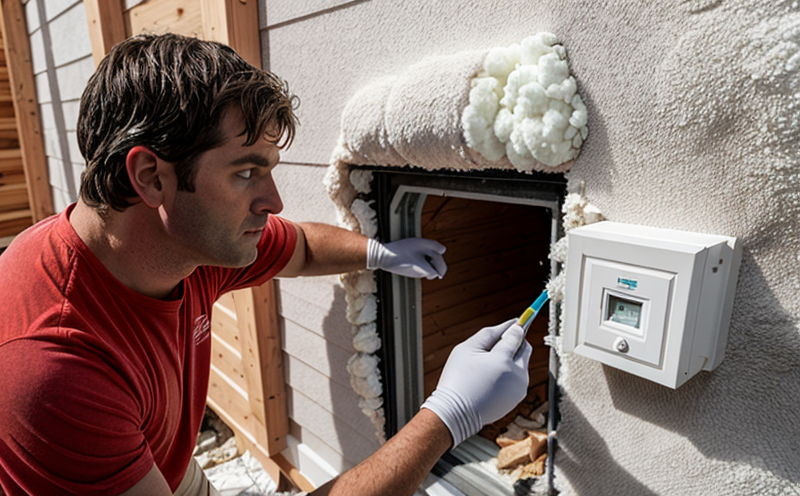EN 13165 Performance Testing of Foam Panels
The European standard EN 13165-1:2007 specifies methods for the determination of thermal resistance, heat transfer coefficient and other performance characteristics of rigid foam panels used in building insulation. This testing is critical for ensuring that insulating materials meet regulatory requirements and deliver the expected performance in real-world conditions.
The standard covers a wide range of foam types including polystyrene (PS), polyurethane (PU), phenolic foams, and extruded polystyrene (XPS). Testing under EN 13165 ensures that the thermal performance of these materials is accurately measured, which directly impacts energy efficiency in buildings. This testing is particularly important for sectors such as construction, where compliance with insulation standards can significantly reduce heating and cooling costs.
The methodology involves measuring the thermal resistance (R-value) using a guarded hot plate apparatus. The specimen, typically cut to standard dimensions, is exposed to controlled environmental conditions in a climatic chamber. The temperature difference across the material is measured along with heat flow through it. From these measurements, the R-value and other parameters are calculated.
A critical aspect of this testing is the preparation and handling of the foam panels. The specimens must be conditioned for an appropriate period to ensure they reach equilibrium moisture content before testing. This step is crucial because moisture can significantly affect thermal performance. Proper specimen preparation ensures that the results reflect the actual performance of the material in service conditions.
The test apparatus used includes a guarded hot plate with precise temperature control and sensors capable of measuring minute heat flows. The equipment must be calibrated regularly to maintain accuracy. The entire testing process is time-consuming, typically taking several days from specimen preparation to final results reporting.
Understanding the implications of this testing for different foam types highlights its importance in various sectors. For instance, in the construction industry, accurate thermal performance data helps architects and engineers design more energy-efficient buildings. In the HVAC sector, it ensures that insulating materials effectively reduce heat loss or gain, leading to better system performance.
The standard also covers additional testing parameters such as compressive strength, water vapor permeability, and dimensional stability. These properties are essential for ensuring the long-term durability of insulation systems. For instance, in regions with high humidity levels, materials must resist moisture absorption to maintain their thermal resistance over time.
In conclusion, EN 13165-1 is a vital tool for quality assurance and compliance across multiple sectors. It provides precise measurement techniques that ensure the reliability of insulation materials, supporting sustainable construction practices and efficient energy use.
Benefits
Implementing EN 13165 performance testing offers numerous benefits to various stakeholders in the building & infrastructure sector. Compliance with this standard ensures that insulation materials meet strict European regulations, which is essential for market access and customer satisfaction.
For quality managers, the test results provide critical data on material performance, helping them maintain high-quality standards throughout production processes. This assurance translates into consistent product quality across batches, reducing waste and improving overall productivity.
Compliance officers can use these tests to verify that materials meet regulatory requirements, ensuring legal compliance and avoiding costly penalties or reputational damage from non-conformance. R&D engineers benefit from detailed performance data, which aids in continuous improvement of existing products and development of new innovations.
Procurement teams gain confidence in choosing suppliers who adhere to high standards, leading to better supply chain management and cost efficiency through reliable materials that meet project specifications without rework or delays.
Quality and Reliability Assurance
The EN 13165-1 standard is designed not only for performance testing but also to ensure the quality and reliability of foam insulation panels. By adhering to this standard, manufacturers can demonstrate that their products consistently meet or exceed specified performance criteria.
Quality assurance in this context involves several key aspects: precise measurement techniques, accurate calibration of test equipment, and consistent specimen preparation. Each of these elements plays a crucial role in ensuring reliable results.
Precision in measurement is paramount for obtaining accurate thermal resistance values. This requires high-precision instruments capable of detecting minute heat flows. Regular calibration ensures that the equipment remains within specified tolerances throughout its operational life, minimizing potential errors in data collection.
Accurate calibration also extends to environmental controls within climatic chambers used during testing. Proper temperature and humidity settings are essential for obtaining reliable performance metrics. Any deviation from these controlled conditions could lead to incorrect results, making it crucial that facilities maintain strict adherence to standard operating procedures.
Consistent specimen preparation is another critical factor in ensuring quality and reliability. Specimens must be cut to precise dimensions and conditioned under specific temperature and humidity conditions before testing begins. Failure to follow these protocols can result in variable test outcomes, undermining the consistency of results across different batches or suppliers.
Competitive Advantage and Market Impact
Adopting EN 13165 performance testing offers significant competitive advantages and market impacts for companies operating in the building & infrastructure sector. Compliance with this standard signals to customers, regulators, and stakeholders that a company prioritizes quality and regulatory adherence.
In terms of customer satisfaction, meeting or exceeding the specified thermal resistance values enhances product reputation and marketability. This can lead to increased demand from discerning clients who value sustainability and energy efficiency in their construction projects. By offering materials that consistently perform as expected, companies build trust with their customers and differentiate themselves from competitors.
Regulatory compliance is another key factor influencing competitive positioning. Many regions have stringent regulations regarding the thermal performance of building insulation materials. Companies that comply with international standards like EN 13165 are better positioned to operate across diverse markets without facing regulatory hurdles or costly non-compliance issues.
The impact on the broader market extends beyond individual companies. By setting a high standard for performance, sectors such as construction and HVAC contribute positively to overall industry trends towards greater energy efficiency and sustainability. This collective effort can drive innovation in insulation materials and techniques, ultimately benefiting end-users through more efficient buildings that reduce operational costs.





